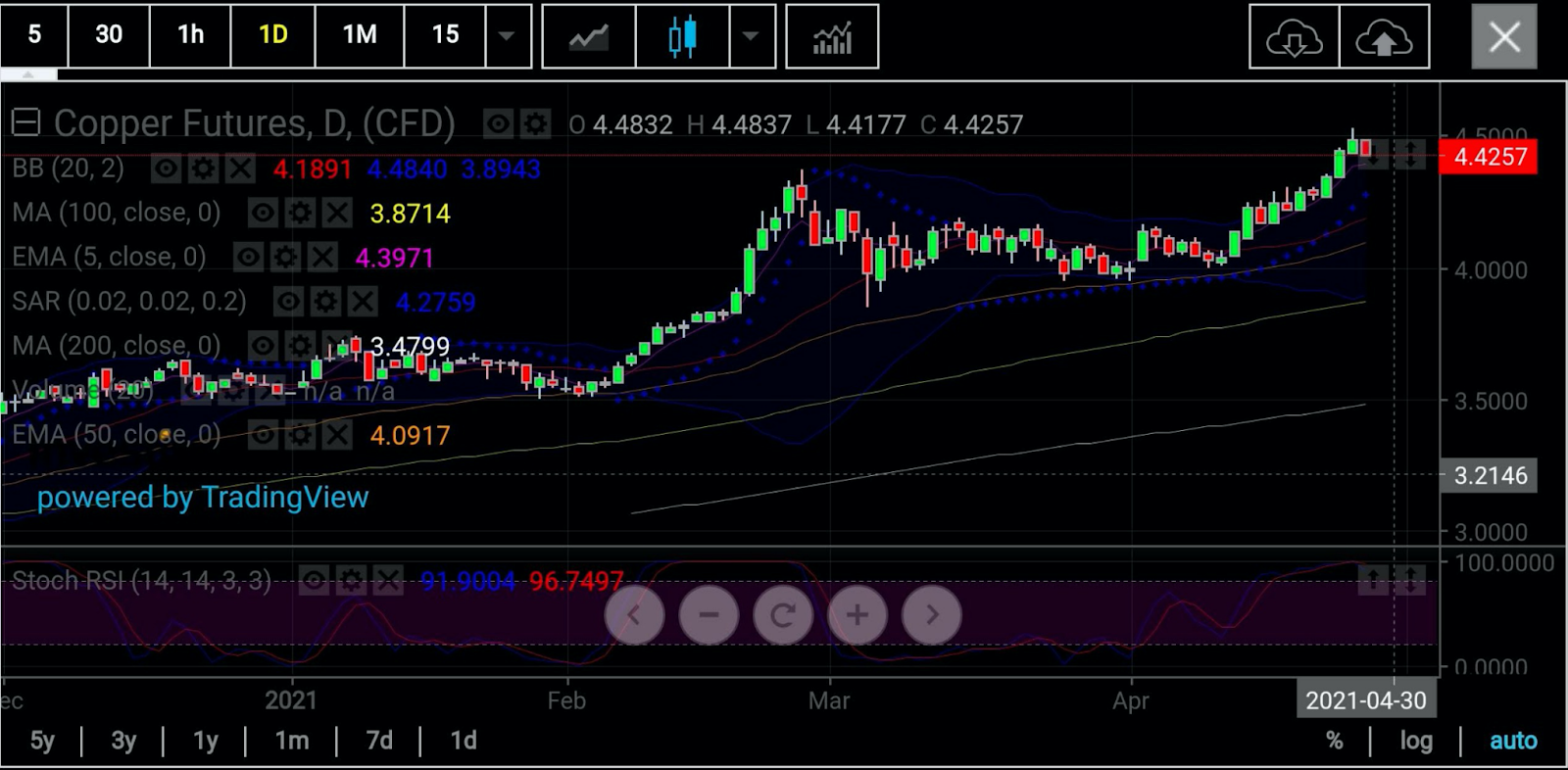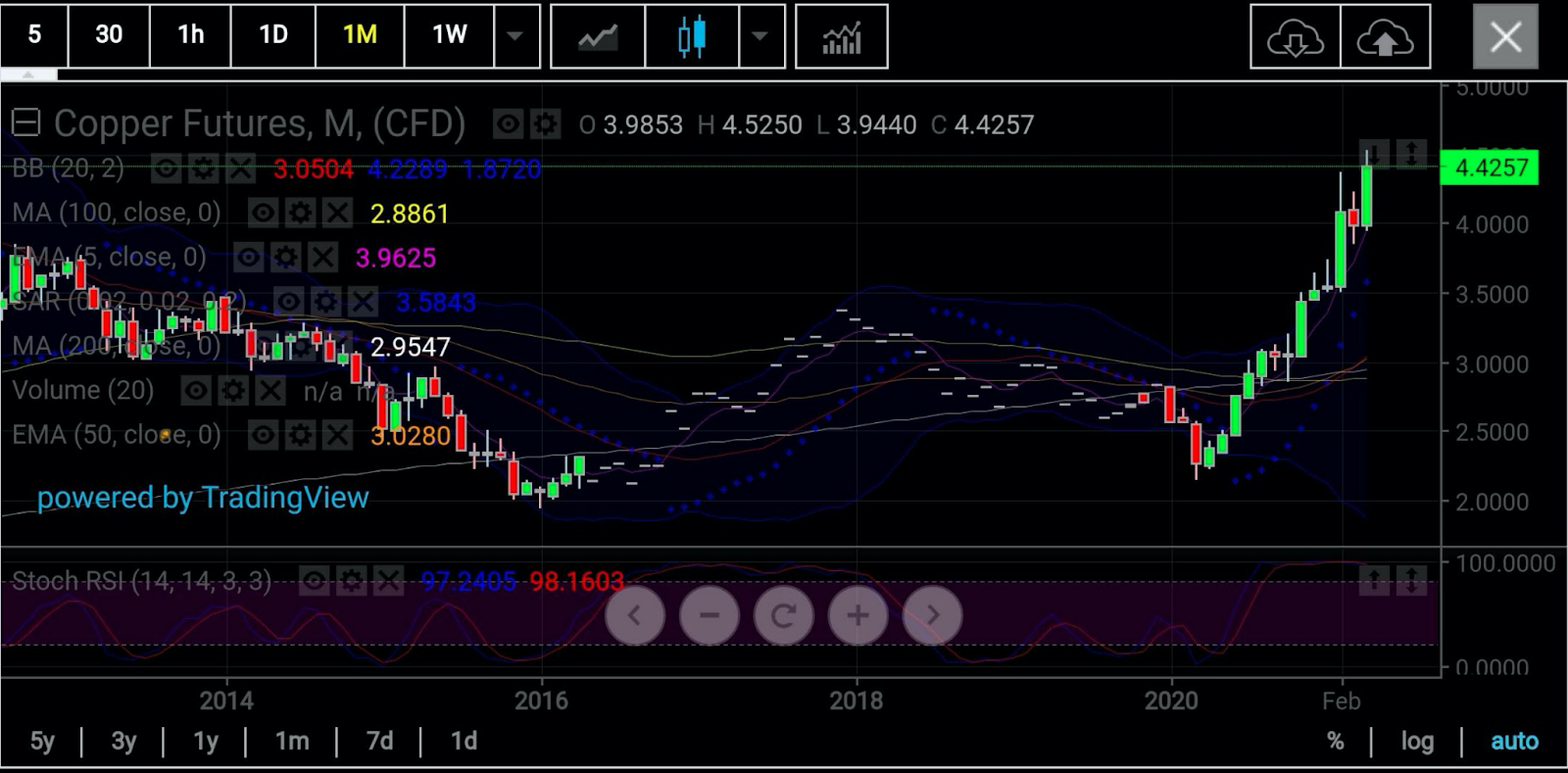Copper is headed for its second month in three of double-digit gains, after hitting a 10-year high. But that’s not why you’re here. You’re reading this to find out if it has more to go and it’s not too late to join the party—or if you’re already invested, to reaffirm that you should stay.
I’m here to tell you those three things, and another: That it might not be a bad idea to double down on your holdings of copper as this could easily be one of your top five—or even top three—commodity winners of the year.
As trading for April rounds out, spot copper on New York’s COMEX and three-month copper futures on the LME, or London Metal Exchange, are both up 11%, after a February gain of just over 15% each.
For the year, the red metal, as it’s also called, is up more than 25%.
That puts it behind top energy acts gasoline (44%) and US crude and heating oil-diesel (which are both tied at 29%) but almost on par with Brent, the global crude benchmark, which is up just over 26%.
There are other exceptional gainers in commodities, like corn and soybeans, which have risen more than 30% each from a perfect storm of crop-retarding weather and explosive demand.
In metals, including gold, copper is the biggest bet for those playing the long game. The exception is tin, which is up 30% due to a chronic, multi-year long supply deficit.
Two Of The Biggest Growth Stories: China And The US
Fundamentally, copper is also a solid bet backed by two of the biggest growth stories emerging from the coronavirus pandemic: the Chinese and US economies.
As China rebuilds from the devastation of the pandemic, it is displaying almost a second version of its infrastructure roll-out in 2000 that made it the largest consumer of metals, particularly copper.
Even prior to COVID-19, the EU was on the path to a green revolution that requires enormous amounts of copper in the coming years for the electrification of most new vehicles sold in the bloc and the charging stations needed to power them. That’s not including the copper required for cabling and electricity conduction in other industries moving away from polluting fossil fuels.
On top of these, we now have the Biden administration’s aim of halving all American emissions by 2030.
The US green proposals include subsidies for private ownership of electric cars and adding 500,000 new charging stations across the country; converting 500,000 school buses and the entire government transportation fleet to zero-emission vehicles.
Those stations, and that number of battery-run electric buses, would alone require nearly 200,000 tonnes of copper, according to an estimate by investment bank Jefferies. Renewable energy typically requires an estimated five times more copper than conventional sources.
Goldman Sachs: Copper Could Reach $15,000 By 2025
The combined China, EU and US demand for copper is probably what led Goldman Sachs to predict two weeks ago that the metal could go to $15,000 per ton on the LME by 2025, from its current rate of $9,000.
Copper will be crucial in achieving decarbonization and replacing oil with renewable energy sources, and right now, the market is facing a supply crunch that could boost the price by more than 60% in four years, Goldman said.
But, by the turn of decade, demand is likely to fly, surging as much as 900% between now and 2030 to reach 8.7 million tons if green technologies are adopted en masse, Goldman estimates. Even if this process is slower, demand will still surge to 5.4 million tons, or by almost 600%, says the bank, calling copper the “new oil.”
In an update released early Wednesday, Goldman predicted this for a ton of copper on the LME:
“We upgraded our copper forecast to average $9,675/t in 2021, $11,875/t in 2022 and $12,000/t in 2023 before a material step-up to $14,000/t in 2024 and $15,000/t in 2025. In this context, we also upgraded our 12-month target to $11,000/t.”
Except for the 2021 average, the forecast prices were all higher than the $9,964.25 peak reached on the LME on Tuesday, which was the highest since February 2011.
Now, as positive as I am about copper, electrification, new energies and the promise of a planet with a smaller carbon footprint, I have also seen much hyperbole from Wall Street investment banks.
I do not own any copper and have no intention to buy any given my strict policy of non-trading to ensure no bias in my research and reporting of the various commodity markets. But if I were to invest in copper, I’d confine my outlook to three or five-year horizons at most and update them regularly. That’s what I suggest you do.
And if immediate and near-term impacts are more relevant to you, then ongoing mine disruptions in Chile, the world’s largest producer of copper, make a compelling narrative as to why prices of the metal should go higher.
The latest supply disruption threat in copper came on Monday after Chilean port workers called for a strike action in response to President Sebastian Piner's move to block a bill that would have allowed them to make a third round of early withdrawals from their pension funds.
"Metals supply risk is receiving a jolt as Chilean port workers threaten to disrupt copper shipments for the world's largest producer nation. At the same time, reflation signals continue to fire on all cylinders, providing a powerful combination for sharply higher prices," TD Securities said, commenting on the furor in Chile, which produces a quarter of the world’s copper.
Interestingly, TD Securities admitted that its own copper short trades—it’s fascinating that an investment bank known to specialize in metals would actually be bearish on copper at this time—were stopped out in the process as prices hit 10-year highs.
"While tracking global freight rates and loading times suggests bottlenecks could already be easing, with these gauges well below February highs, a potential Chilean port strike is a substantial risk given already-tight concentrate markets (for copper). In this context, even a modest disruption could have an outsized impact on prices," said Bart Melek, head of commodity strategy at TDS.
Technically too, copper seems on solid ground to make newer highs in the near-term, says Sunil Kumar Dixit, technical analyst at S.K. Dixit Charting in Kolkata, India.
All charts courtesy of S.K. Dixit Charting
Dixit, who bases his call on COMEX copper’s 10-year highs of $4.5250 per lb on Tuesday, says:
“Having successfully broken out above the key levels of $4.10 and $4.38, COMEX copper has pierced through $4.50. We have a target of $4.65 in the next leg.”

Dixit, however, adds that with COMEX copper’s Stochastic Relative Strength Index reading at 91.90 /96.75, there could be an interim price reversal in the near-term.
The spot contract for New York-traded copper was down 6 cents, or 1.3%, at $4.42 per lb in Wednesday’s early trade.
“If there’s a breather, we could consolidate to support areas of $4.38 to $4.30 and $4.10,” Dixit said. “It’s a bearish top that could last two to three days, before a turnaround.”

Disclaimer: Barani Krishnan uses a range of views outside his own to bring diversity to his analysis of any market. For neutrality, he sometimes presents contrarian views and market variables. He does not hold a position in the commodities and securities he writes about.
